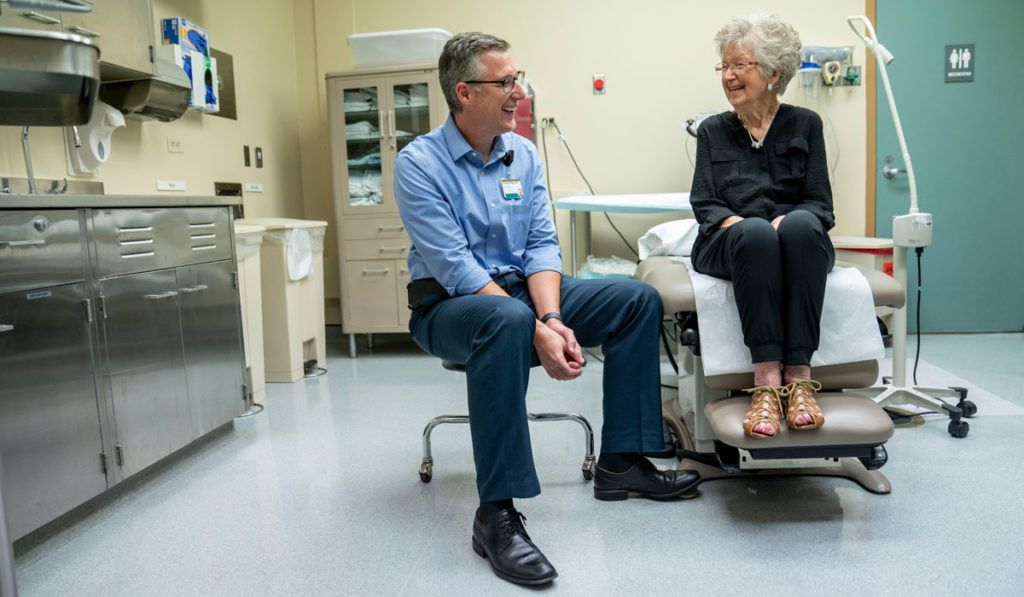Enhanced recovery after surgery (ERAS) has been shown to standardize and coordinate perioperative care, reduce opioid use, improve patient recovery, and lower costs.
ERAS was launched at Vanderbilt University Medical Center in 2014 to address intra-abdominal surgery cases. It now spans multiple service lines including surgical weight loss, ureteroscopic stone treatment, major gynecologic surgery and a protocol for geriatric hip fracture, with many others in the queue.
The initiative is led by Timothy Geiger, M.D., chief of Vanderbilt’s Division of General Surgery and executive medical director of the Surgery Patient Care Center, and Matthew McEvoy, M.D., a professor and vice chair for education in the Department of Anesthesiology.
“We realized that we could deliver higher-quality care through communication and coordination throughout the perioperative care arc,” said Geiger. “The fact that we now have such a robust program is because we had an engaged anesthesia group that was willing to take this on.”
Geiger and McEvoy have been charged by Vanderbilt leadership to implement this form of evidence-based practice and care standardization for all service lines.
“Our primary objective is standardization with personalization.”
“If there’s a definable service line, whether it’s ambulatory or inpatient, we’re looking to collaborate and implement these principles,” McEvoy said.
Expanding Expertise
The ERAS team begins by reviewing all care components of an individual service line and matching them with the latest evidence in perioperative care. They have two goals: improve perioperative communication and decrease unnecessary variability. Endpoints are improving patient recovery while reducing length of stay, complications and cost.
In addition to the core steering committee with Warren Sandberg, M.D., chief of staff at Vanderbilt University Adult Hospital, as the executive sponsor, the team now includes an ERAS coordinator, a program manager, and an analytics lead responsible for establishing order sets, managing enterprise analytics, and building performance dashboards.
As appropriate, clinical specialists are brought in including physical therapy, occupational therapy, pharmacy, and nutrition, “really all the services in the hospital that surround any patient,” Geiger said. “We’re looking at that service line, that disease, that population to make sure we have a unified best practices model.”
“Our primary objective is standardization with personalization. That is, we are more concerned with applying evidence-based principles – for example, opioid minimization – rather than just a specific checklist of actions,” McEvoy explained. “We don’t want to be so rigid we can’t take the individual patient into consideration.”
Safeguarding High-risk Patients
Adjacent to the ERAS program, McEvoy established the High-Risk Surgical Encounter (Hi-RiSE) Clinic with an interprofessional team.
“If there’s a definable service line, whether it’s ambulatory or inpatient, we’re looking to collaborate and implement these principles.”
The clinic performs structured evaluations for surgical patients at high risk of complications such as delirium, adverse cardiac events, postoperative pulmonary complications, acute kidney injury, postoperative infections, and hyperglycemia. Services offered in preparation for surgery may include optimization of anemia, malnutrition, cardiac or pulmonary disease, and help with smoking cessation. This is coordinated with intraoperative and postoperative care planning to ensure patients are fully ready for a successful procedure.
This fall, the researchers will launch a randomized controlled trial testing whether preoperative medical optimization (through Hi-RiSE) is better than standard preoperative evaluation in patients undergoing major intra-abdominal surgery.
“As surgeons, we always want to operate to fix the problem as soon as we can,” Geiger said.
“It is a cultural shift to say, ‘I’m going to hit the brakes; I’m going to let the patient get ready and then we’re going to the OR.’ But when you optimize a patient before surgery, they recover better.”
Tracking ERAS Metrics
As they achieve success in multiple service lines, the ERAS team is publishing their results.
“We don’t want to be so rigid we can’t take the individual patient into consideration.”
In a study of 1,182 colorectal surgery patients, their research found that the ERAS program was associated with significantly reduced complication rates across a range of organ categories. This led to a more than 1.5-day reduction in length of stay and reduced total hospital costs by more than 20 percent.
Another study looked at the addition of goal-directed hemodynamic therapy in colorectal surgery, one recommended component of ERAS programs. The pathway for ureteroscopic stone treatment demonstrated increased patient satisfaction and dramatically lowered opioid consumption after surgery. New studies examine postoperative walking and its effect on length of stay and a comparison of preclinical components to surgical outcomes.
“With these process and outcomes metrics in hand, we are beginning to confirm what works and what doesn’t,” Geiger said.






